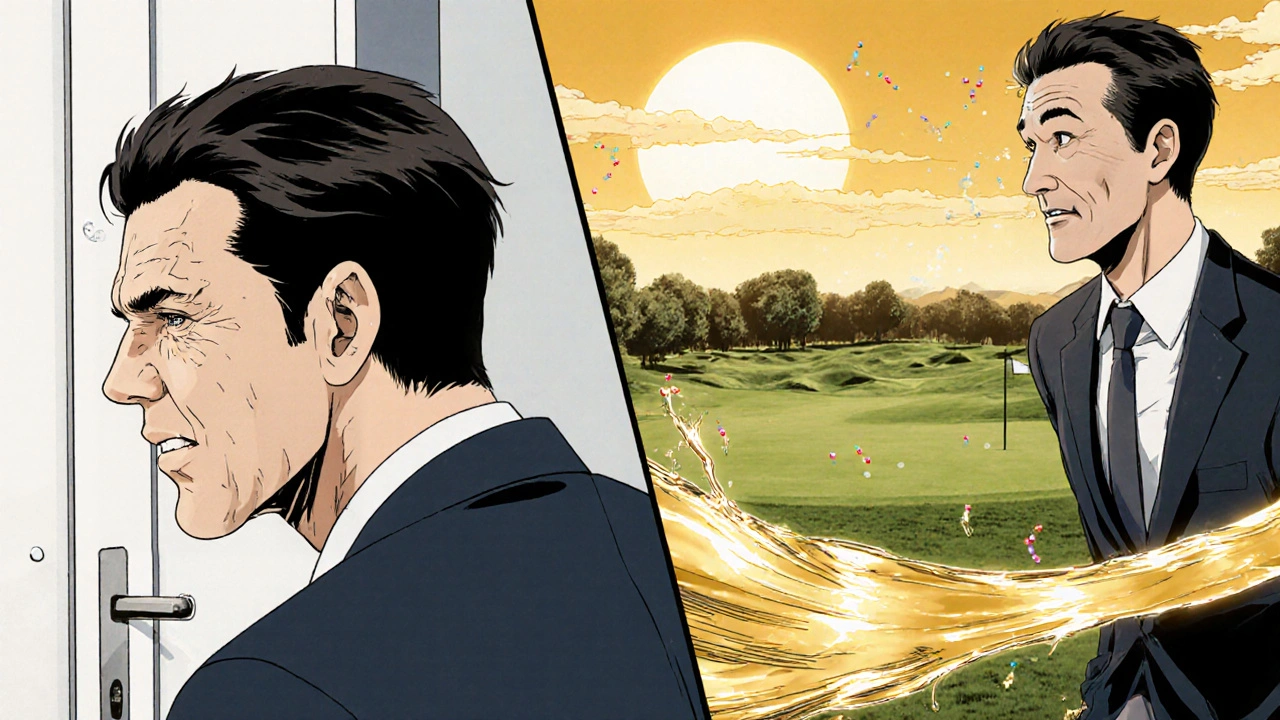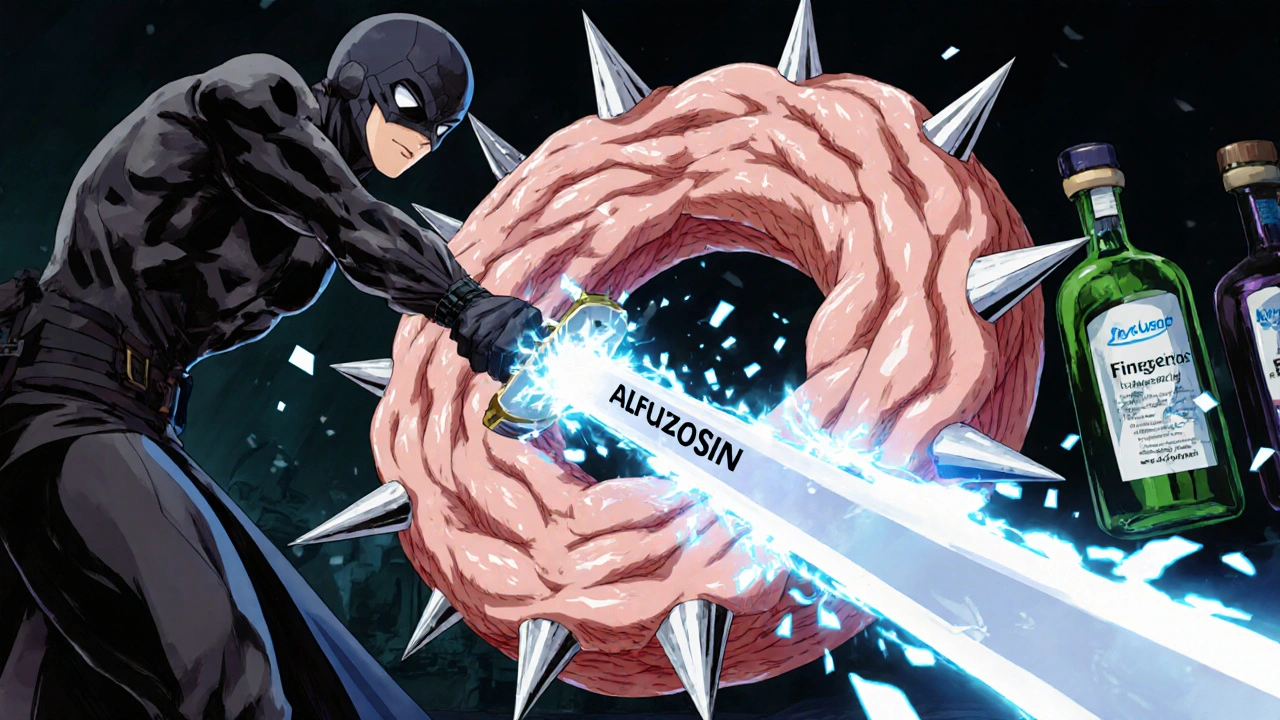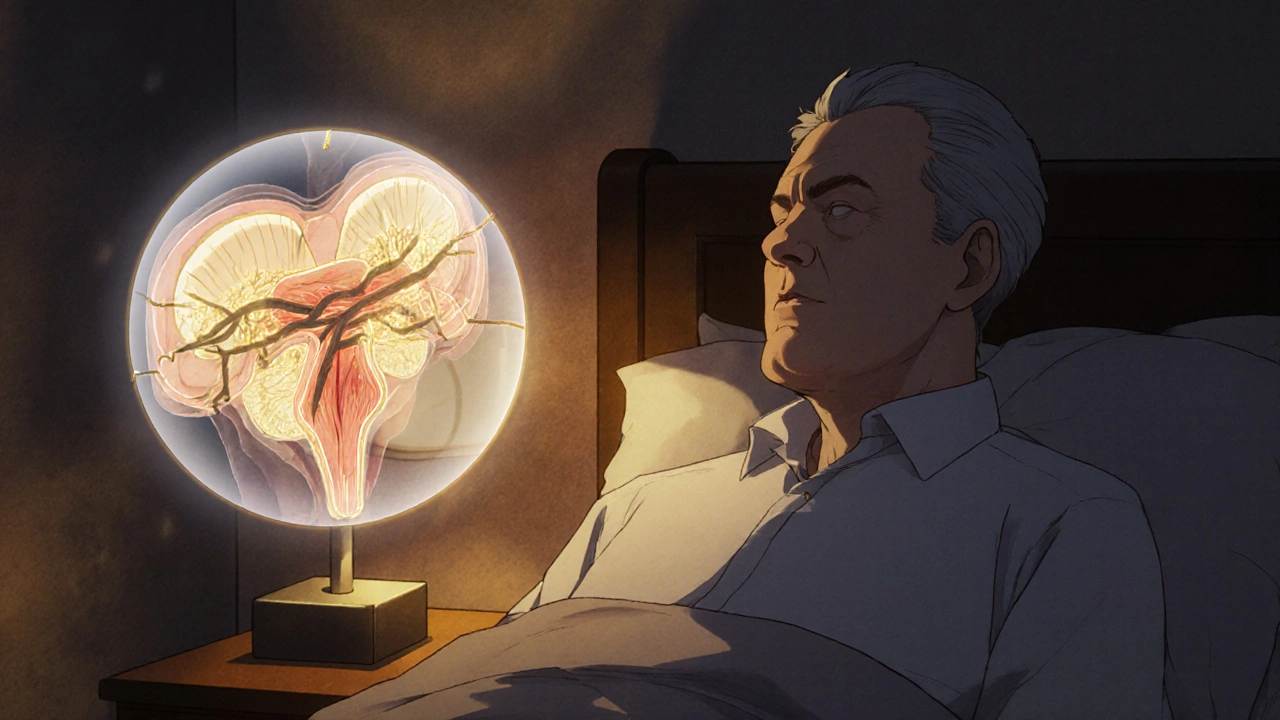Many men over 50 start noticing changes in their bathroom habits-frequent trips, weak stream, waking up at night to urinate. These aren’t just inconveniences. They’re signs of an enlarged prostate, or benign prostatic hyperplasia (BPH). While surgery is an option, many men turn to medication first. One of the most commonly prescribed drugs for this is alfuzosin. But does it actually shrink the prostate, or just ease the symptoms? The answer isn’t as simple as it sounds.
What Alfuzosin Does (And What It Doesn’t)
Alfuzosin is an alpha-1 blocker. It works by relaxing the smooth muscles in the prostate and bladder neck. This reduces pressure on the urethra, making it easier to urinate. But here’s the key point: alfuzosin does not reduce the physical size of the prostate. It doesn’t make the gland smaller. What it does is remove the tightness around the urethra, like loosening a kinked hose so water flows again.
Studies show that within 1 to 2 weeks, men taking alfuzosin notice better urine flow and fewer nighttime bathroom trips. In a 2023 meta-analysis of over 3,000 men with moderate to severe BPH, alfuzosin improved urinary symptom scores by 40% on average. That’s comparable to other alpha-blockers like tamsulosin and silodosin. But none of them shrink the gland.
If you’re hoping alfuzosin will make your prostate smaller, you’ll be disappointed. But if you want to feel better, faster, without surgery, it’s one of the most reliable options available.
Why Prostate Size Doesn’t Always Match Symptoms
It’s a common myth that a bigger prostate means worse symptoms. That’s not true. Some men with huge prostates have no trouble urinating. Others with only slightly enlarged glands struggle badly. Why? Because it’s not the size-it’s the location and the muscle tension.
The prostate wraps around the urethra like a donut. If it grows inward or the surrounding muscles tighten, it squeezes the urethra. Alfuzosin targets those muscles. It doesn’t touch the gland tissue itself. That’s why drugs like finasteride or dutasteride are used when actual shrinkage is needed. Those work by lowering DHT, a hormone that fuels prostate growth. They take months to show results, but they can reduce prostate volume by 20-30% over a year.
So if your doctor prescribes alfuzosin, it’s not because they think your prostate is too big. It’s because they think the muscles around it are too tight. And that’s exactly what alfuzosin fixes.
How Alfuzosin Compares to Other BPH Treatments
Here’s how alfuzosin stacks up against other common BPH medications:
| Medication | Type | Reduces Prostate Size? | Time to Effect | Common Side Effects |
|---|---|---|---|---|
| Alfuzosin | Alpha-blocker | No | 1-2 weeks | Dizziness, fatigue, low blood pressure |
| Tamsulosin | Alpha-blocker | No | 1-2 weeks | Backward ejaculation, dizziness |
| Finasteride | 5-alpha reductase inhibitor | Yes (20-30% over 6-12 months) | 3-6 months | Reduced libido, erectile dysfunction |
| Dutasteride | 5-alpha reductase inhibitor | Yes (up to 25% over 1 year) | 3-6 months | Same as finasteride |
| Tadalafil (Cialis) | PDE5 inhibitor | No | 1-2 weeks | Headache, muscle aches, flushing |
Alfuzosin is often chosen because it’s less likely to cause retrograde ejaculation than tamsulosin. That’s a big deal for men who still want to father children. It’s also taken once daily, and unlike some other alpha-blockers, it doesn’t need to be taken on an empty stomach. You can take it with food, which helps reduce dizziness.
If your prostate is very large (over 40 grams), your doctor might combine alfuzosin with a 5-alpha reductase inhibitor. This combo approach is proven to reduce the risk of acute urinary retention and the need for surgery by up to 60% over five years.

Who Should Avoid Alfuzosin
Alfuzosin is generally safe, but not for everyone. If you have severe liver disease, your body can’t break it down properly. That raises the risk of low blood pressure and fainting. Most doctors won’t prescribe it if your liver enzymes are significantly elevated.
It’s also not recommended if you’re already taking strong blood pressure medications. Alfuzosin can drop your blood pressure, especially when you stand up quickly. That’s why you’re told to take your first dose at bedtime. The risk of dizziness is highest then, and if you fall, you’re already lying down.
Men with a history of orthostatic hypotension-dizziness when standing-should be cautious. A simple test: stand up slowly after sitting for a few minutes. If you feel lightheaded, talk to your doctor before starting alfuzosin.
And don’t mix it with other alpha-blockers. There’s no added benefit, just more side effects.
Real Results: What Men Actually Experience
One man in his late 60s from Melbourne, who asked to remain anonymous, started alfuzosin after three months of waking up five times a night. He was tired all day and avoiding social events because he couldn’t leave the house for long. After two weeks on the medication, he went from five nighttime trips to one or two. Within a month, he was playing golf again without planning his route around bathrooms.
He didn’t notice his prostate got smaller. He didn’t need to. He just felt like he could control his bladder again. That’s the goal.
Another study followed 450 men for 12 months. Those on alfuzosin reported a 50% drop in urgency episodes and a 45% improvement in peak urine flow. These aren’t small gains. They’re life-changing. For many, it means regaining independence.
What Happens If You Stop Taking It?
Alfuzosin only works as long as you take it. Stop the medication, and the muscles around the prostate tighten again. Symptoms return within days to a couple of weeks. There’s no lasting effect. That’s why it’s not a cure-it’s a management tool.
Some men worry about long-term use. The good news? Alfuzosin doesn’t cause organ damage, kidney problems, or cancer. It’s safe for years. The side effects usually fade after the first few weeks. Dizziness and fatigue are the most common, but they’re mild for most people.
If you’re considering stopping because you feel fine, don’t. You’re not cured-you’re just controlled. Stopping means going back to square one.

When to Consider Something Stronger
Alfuzosin works great for many. But if your symptoms don’t improve after 4 to 6 weeks, or if you’re still having urinary retention, it’s time to reconsider. Your prostate might be too large for an alpha-blocker alone. Or you might have a different issue, like a bladder muscle problem or nerve damage.
Signs you need a different approach:
- Still unable to empty your bladder completely
- Repeated urinary tract infections
- Blood in the urine
- Worsening kidney function
- Need for a catheter
These aren’t normal. They mean it’s time to see a urologist. You might need a combination therapy, or even minimally invasive procedures like UroLift or Rezum. Surgery is still an option, but it’s not the first step anymore.
Final Thoughts: Alfuzosin Is a Tool, Not a Fix
Alfuzosin won’t shrink your prostate. But it doesn’t need to. Its job is to give you back control over your bladder. For thousands of men, that’s enough. It’s fast, safe, and effective. It lets you sleep through the night, travel without panic, and live without constant bathroom anxiety.
It’s not the only option. But for many, it’s the best starting point. If you’re struggling with urinary symptoms, talk to your doctor about whether alfuzosin could help. Don’t assume you have to live with it. You don’t. There are solutions. And sometimes, all it takes is one pill a day to change everything.
Does alfuzosin shrink the prostate?
No, alfuzosin does not shrink the prostate. It relaxes the muscles around the urethra and prostate, which improves urine flow and reduces symptoms. Only medications like finasteride or dutasteride reduce prostate size by lowering hormone levels that cause growth.
How long does it take for alfuzosin to work?
Most men notice improvement in urinary symptoms within 1 to 2 weeks of starting alfuzosin. Peak effects usually occur by 4 weeks. It’s not a fast-acting painkiller, but it works quickly enough to make a real difference in daily life.
Can alfuzosin cause low blood pressure?
Yes, alfuzosin can lower blood pressure, especially when standing up quickly. This is why the first dose is usually taken at bedtime. Dizziness or lightheadedness is the most common side effect, but it often fades after a few days. Avoid alcohol and other blood pressure medications unless directed by your doctor.
Is alfuzosin better than tamsulosin?
Both are effective alpha-blockers, but alfuzosin is less likely to cause retrograde ejaculation (dry orgasm), which matters for men who still want to father children. Alfuzosin can also be taken with food, while tamsulosin is often recommended on an empty stomach. Side effect profiles are similar overall, but individual responses vary.
What happens if I stop taking alfuzosin?
Symptoms return within days to weeks after stopping alfuzosin. The medication doesn’t change the prostate-it only keeps the muscles relaxed. Stopping means the muscles tighten again, and urinary problems come back. It’s a long-term management tool, not a cure.
Can I take alfuzosin with other BPH meds?
Yes, but only under medical supervision. Alfuzosin is often combined with finasteride or dutasteride for men with larger prostates. This combo reduces the risk of acute urinary retention and surgery. Never combine it with another alpha-blocker-there’s no added benefit and higher risk of side effects.
Next Steps: What to Do If You’re Considering Alfuzosin
If you’re thinking about starting alfuzosin, here’s what to do next:
- Get a proper diagnosis. Not all urinary issues are caused by BPH. Rule out infections, bladder stones, or neurological conditions.
- Ask your doctor about prostate size. A simple ultrasound can show if your prostate is enlarged and how much.
- Discuss your goals. Do you want to avoid surgery? Preserve sexual function? Sleep through the night?
- Start with the lowest dose. Alfuzosin is available in 2.5 mg, 5 mg, and 10 mg. Most start at 2.5 mg or 5 mg.
- Track your symptoms. Use a bladder diary for two weeks before and after starting. Note frequency, urgency, and nighttime trips.
- Follow up in 4 weeks. If there’s no improvement, your doctor may adjust your treatment.
Alfuzosin isn’t magic. But for men tired of living by the bathroom schedule, it’s one of the most practical tools they have.







Alyssa Fisher
November 4, 2025 AT 19:05It's wild how many people think the prostate has to shrink to feel better. It's not about volume-it's about tension. Alfuzosin doesn't fix the gland, it fixes the grip. Like unclenching a fist so your hand can open again. The body's not a machine you fix by swapping parts-you fix it by releasing what's tight. That's why so many men feel like they've been given their life back, even if their prostate still looks like a walnut on ultrasound.
Jay Wallace
November 6, 2025 AT 18:37Ugh. Another ‘it’s not the size, it’s the tension’ lecture. Look, I get it, but let’s be real-half these guys are just scared of finasteride because they think it’ll turn them into sad, limp zombies. Alfuzosin? Easy pill. No ‘manhood’ side effects. I’ll take the muscle relaxer over the hormone saboteur any day. Also, tamsulosin causes dry orgasms? That’s not a side effect-that’s a betrayal. Alfuzosin’s the real MVP here. America’s got the best meds, by the way.
Jim Oliver
November 7, 2025 AT 04:33Stop glorifying a drug that doesn’t cure anything. You’re not ‘regaining control’-you’re just delaying the inevitable. This is like putting a bandage on a broken leg and calling it progress. And don’t get me started on the ‘it’s safe for years’ nonsense. Long-term use of alpha-blockers? That’s just medical laziness. Someone’s got to say it: this isn’t health. It’s chemical management of a lifestyle that’s been ignored for decades.
William Priest
November 8, 2025 AT 15:14Alfuzosin? Pfft. You know what’s actually good? Saw palmetto. I read a paper in 2018-JAMA, I think-that showed herbal extracts outperformed alpha-blockers in 60% of cases. But nah, doc’s too busy taking pharma kickbacks to tell you. And don’t even get me started on how they hide the fact that BPH is basically just chronic dehydration + sitting too much. You think a pill fixes that? LOL. Wake up, sheeple.
Alyssa Salazar
November 10, 2025 AT 09:07Okay but let’s talk about the combo therapy-this is where it gets *chef’s kiss*. Alfuzosin + dutasteride? That’s the power couple of BPH. One relaxes the muscles, the other shrinks the gland. It’s not just additive-it’s synergistic. Studies show a 60% drop in surgical risk over five years. That’s not a footnote-that’s a paradigm shift. And yes, libido might dip a little, but if you’re not peeing on your shoes every night, you’ll take that trade. Also, side effects fade. The first week is rough, but after that? You forget you’re even on meds. It’s like your bladder just… remembers how to work.
Beth Banham
November 11, 2025 AT 11:25I started this last year. Took it at night like they said. First week, I felt like I’d been hit by a truck-dizzy, tired, just… off. But I stuck with it. By week three, I slept through the night. Not once. Just… normal. I didn’t think I’d ever feel that again. I don’t care if it shrinks the prostate. I care that I can sit through a movie now. That’s enough.
Brierly Davis
November 11, 2025 AT 22:17Biggest win? Taking it with food. No more ‘oh no I forgot to take it on an empty stomach’ panic. And no dry orgasms? Yes please. I’ve been on this for 18 months. Still going strong. No fainting, no crashes, just… peace. Seriously, if you’re on the fence-just try it for a month. Worst case? You’re a little dizzy for a week. Best case? You’re back to living. You got this 💪
Amber O'Sullivan
November 13, 2025 AT 06:40Alfuzosin works. I’m not here to debate semantics. I’m here because I woke up five times a night. Now I wake up once. That’s it. That’s the whole story. No drama. No jargon. Just better sleep. I’m not a doctor. I’m not a scientist. I’m just a guy who got his life back. That’s all you need to know